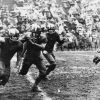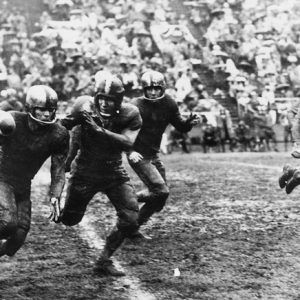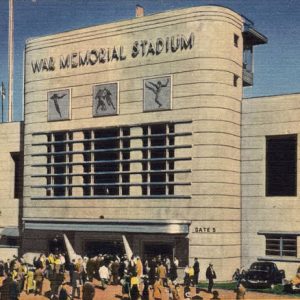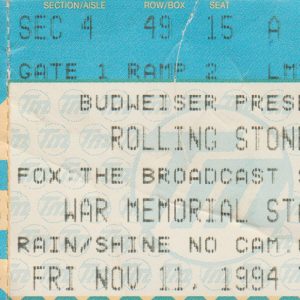calsfoundation@cals.org
War Memorial Stadium
War Memorial Stadium, built in 1947, is located in Little Rock (Pulaski County). The venue has been home to numerous events, including football games featuring the Razorbacks of the University of Arkansas (UA) in Fayetteville (Washington County). Since its opening in War Memorial Park, the stadium has drawn millions of spectators to central Arkansas and has had a tremendous impact on the local economy.
In 1947, the Arkansas state government paid $1.2 million to build the stadium. Architect Bruce R. Anderson designed the venue, which had an original seating capacity of 31,075. The stadium’s first event, a football game between UA and Abilene Christian, was held on September 18, 1948. Before the game, the stadium was formally dedicated by former Razorback and Medal of Honor recipient Maurice Britt to the memory of Arkansas veterans who had given their lives in the two world wars. The venue became a secondary home for the Fayetteville-based Razorbacks, who had played nearly 200 games there by 2012.
In 2000, the stadium was at the center of a controversy dubbed “The Great Stadium Debate,” when UA athletic director Frank Broyles announced plans to move at least one additional home game from Little Rock to Fayetteville. War Memorial had been hosting two or three Razorbacks games per year, providing not only a boost for the local economy but also an opportunity for Little Rock–based alumni to attend games more easily. Little Rock politicians and business leaders, many of them UA graduates, responded with outrage to Broyles’s announcement. Broyles relented, and through 2012, the Razorbacks remained under contract to play two games per year at War Memorial, despite ongoing arguments both for and against the arrangement. However, in late 2013, it was announced that this would be reduced to one game per year, with the Razorbacks scheduled to play their last game at the stadium in 2018. On May 17, 2018, an agreement was announced whereby the Razorbacks would continue to play at War Memorial every other year from 2019 to 2024.
In 2021, the Razorbacks played the Golden Lions of the University of Arkansas at Pine Bluff (UAPB) at War Memorial, the first time they had played an in-state team since the days of Coach John Barnhill, and a much-anticipated match against the Red Wolves of Arkansas State University was scheduled for September 6, 2025; that game ended up being a rout, with the Razorbacks winning 56–14. Prior to that game, the Southeastern Conference had announced that it was moving to a nine-game schedule the following year, adding an extra conference game to the lineup and thus decreasing the likelihood that the Razorbacks would play a nonconference game at War Memorial, but Governor Sarah Huckabee Sanders urged both universities “to make this historic matchup an annual event at War Memorial Stadium, in the heart of our state.”
In addition to Razorbacks games, the stadium hosts the annual Delta Classic football game between UAPB and a selected opponent. The venue also hosts the Arkansas Activities Association’s annual high school football championship games. Two local high schools, Benton (Saline County) and Bryant (Saline County), have played their annual rivalry game, the Salt Bowl, at War Memorial, sometimes drawing as many as 30,000 fans, but in 2025 that game was moved the high school stadium in Benton. In addition, Little Rock Catholic High School plays all of its home games at the stadium. Beyond sports, the venue has also hosted numerous other events, including concerts by popular acts such as the Rolling Stones, the Eagles, Elton John and Billy Joel, George Strait, and N’Sync. In 1959 and 1989, evangelist Billy Graham held multi-day events that drew hundreds of thousands, including a young Bill Clinton at the former. The stadium was listed on the Arkansas Register of Historic Places on September 28, 1998.
Since 1948, the stadium has undergone several expansions. In 1967, its capacity increased to 53,727, and the capacity was expanded to 54,120 in 2010. On June 23, 2010, the War Memorial Stadium Commission signed an agreement to name the playing surface “AT&T Field,” a deal slated to provide the stadium with $175,000 a year in revenue for five years, with a possibility of extension to ten. On August 26, 2010, the commission completed an eight-month, $7.3 million renovation that featured a new, three-story press box and major improvements in club seating.
During the 2017 session of the Arkansas General Assembly, a proposal was made to end state support of War Memorial Stadium. Local business and political leaders worried about the long-term effects of this loss of state aid, and Governor Asa Hutchinson, instead, proposed that the stadium be placed under the direction of the Arkansas Department of Parks and Tourism. On February 22, 2017, he signed a bill to that effect.
For additional information:
Berry, Cody. “From Truman to Topgolf: A History of War Memorial Park in Little Rock.” Pulaski County Historical Review 70 (Spring 2022): 2–17.
Brinkley, Rhett. “The War for War Memorial.” Arkansas Times, September 2025, pp. 36–41. Online at https://arktimes.com/arkansas-blog/2025/08/26/the-war-for-war-memorial (accessed August 26, 2025).
Dufalla, Lucas. “Razorbacks Had Economic Boost for Little Rock.” Arkansas Democrat-Gazette, September 4, 2025, pp. 1A, 5A. Online at https://www.arkansasonline.com/news/2025/sep/03/football-economics-razorbacks-game-revenue-was/ (accessed September 4, 2025).
Harper, Doc. “War Memorial Strikes Back.” Arkansas Sports 360, June 2, 2012. Online at http://www.arkansasexpats.com/2012/6/2/3059352/war-memorial-strikes-back(accessed February 8, 2024).
Holt, Tony. “Memorable Razorback Games at War Memorial Stadium.” Arkansas Democrat-Gazette, September 2, 2025. Online at https://www.arkansasonline.com/news/2025/sep/02/memorable-razorback-games-at-war-memorial-stadium/ (accessed September 2, 2025).
———. “Talks of War Memorial Plans Stir Nostalgia.” Arkansas Democrat-Gazette, September 3, 2025, pp. 1A, 6A. Online at https://www.arkansasonline.com/news/2025/sep/02/nostalgia-wafts-amid-uncertainty-surrounding/ (accessed September 2, 2025).
Jennings, Jay. “War Memorial, in Memory.” Arkansas Life (September 2012): 46–49.
Murphy, Tom. “Yurachek Won’t Say UA Can’t Return.” Arkansas Democrat-Gazette, September 5, 2025, pp. 1C, 6C. Online at https://www.arkansasonline.com/news/2025/sep/04/yurachek-wont-say-ua-cant-return/ (accessed September 5, 2025).
Nelson, Rex. “A Real Football Stadium.” Arkansas Democrat-Gazette, September 16, 2018, pp. 1H, 6H.
Reynolds, Andrew. “Home Sweet Homes.” ArkansasRazorbacks.com. http://www.arkansasrazorbacks.com/ViewArticle.dbml?DB_OEM_ID=6100&ATCLID=204991508 (accessed February 8, 2024).
Seifried, Chad, Carli N. Faulkner, Samantha P. Baker, and James F. Piker. “The Development of Razorback and War Memorial Stadiums.” Arkansas Historical Quarterly 75 (Autumn 2016): 181–205.
War Memorial Stadium. http://www.wmstadium.com (accessed February 8, 2024).
Aaron D. Horton
Alabama State University










Comments
No comments on this entry yet.